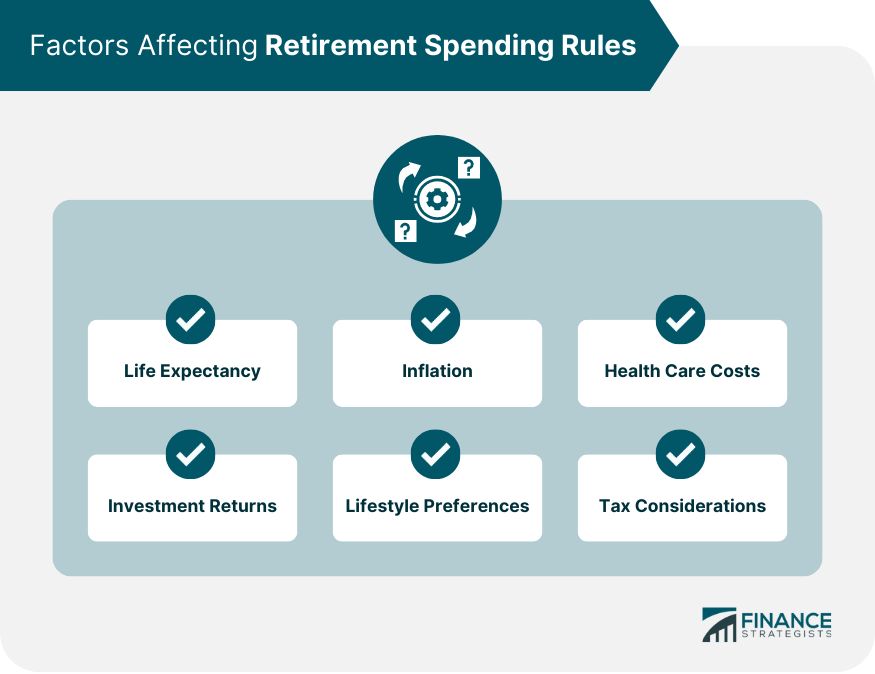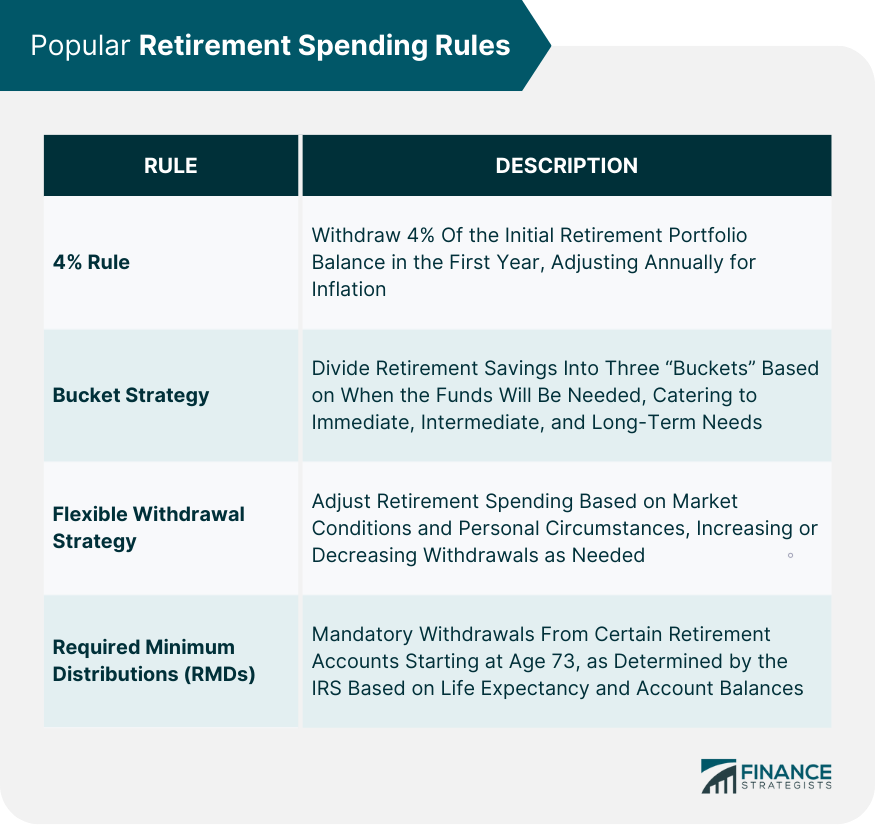Retirement spending rules are guidelines that help retirees manage their finances, maintain their desired lifestyle, and preserve their wealth throughout their retirement years. Having a spending plan during retirement is crucial to ensuring financial security and peace of mind. The primary goals of retirement spending rules are to prevent outliving one's savings, minimize taxes, and maintain a comfortable standard of living. Longer life expectancies require more careful planning to ensure that retirement savings last throughout the entire retirement period. When creating a spending rule, it is important to factor in the possibility of living longer than average. Inflation can erode the purchasing power of money over time, which means retirees may need to withdraw more from their savings to maintain their desired lifestyle. Retirement spending rules should consider the impact of inflation on spending needs. Healthcare costs can be a significant expense during retirement and may rise faster than general inflation. When creating a retirement spending plan, it is essential to account for potential healthcare expenses and long-term care needs. Investment returns can have a significant impact on the sustainability of retirement savings. A spending rule should consider the expected rate of return on investments and be prepared to adjust withdrawals if returns are higher or lower than anticipated. Retirees' spending needs will vary depending on their desired lifestyle. Spending rules should be tailored to individual preferences, including travel, hobbies, and housing choices. Taxes can significantly affect retirement income, and it is important to develop a spending rule that considers the tax implications of various withdrawal strategies. The 4% Rule is a widely used retirement spending rule that suggests withdrawing 4% of the initial retirement portfolio balance in the first year and adjusting the withdrawal amount annually for inflation. This rule is based on historical investment returns and is designed to last for at least 30 years. The 4% Rule is simple to understand and easy to implement. However, it may not be suitable for all situations, as it does not take into account individual circumstances, such as life expectancy or investment returns. The Bucket Strategy divides retirement savings into three "buckets" based on the timeframe in which the funds will be needed. The first bucket contains cash and short-term investments for immediate needs, the second bucket contains bonds and other fixed-income investments for intermediate needs, and the third bucket contains stocks and other growth-oriented investments for long-term needs. The Bucket Strategy provides a structured approach to managing retirement savings and can help retirees maintain a balanced portfolio. However, it may require more active management and regular rebalancing to maintain the appropriate asset allocation. The Flexible Withdrawal Strategy adjusts retirement spending based on market conditions and personal circumstances. This approach may involve increasing withdrawals during good market years and reducing withdrawals during poor market years, or adjusting spending based on changes in personal circumstances, such as health or family needs. The Flexible Withdrawal Strategy can help retirees adapt to changing market conditions and personal circumstances, potentially increasing the sustainability of their retirement savings. However, it requires ongoing monitoring and decision-making, which can be more complex than other strategies. Required Minimum Distributions are mandatory withdrawals from certain retirement accounts, such as traditional IRAs and 401(k)s, starting at age 73. The IRS sets RMD amounts based on life expectancy and account balances. RMDs provide a structured withdrawal plan and help ensure that retirement savings are not spent too quickly. However, RMDs may not align with a retiree's actual spending needs or personal circumstances, and they may not be tax-efficient, as withdrawals are generally taxed as ordinary income. When creating a personalized retirement spending rule, it is essential to consider all sources of retirement income, such as Social Security benefits, pensions, annuities, and investment income. A comprehensive assessment of assets and liabilities, including savings, investments, real estate, and debt, can help retirees determine their overall financial situation and develop an appropriate spending rule. Essential expenses, such as housing, utilities, food, and healthcare, should be prioritized in any retirement spending plan. It is important to ensure that these costs are covered by reliable income sources. Discretionary expenses include travel, hobbies, and entertainment, which can be adjusted depending on a retiree's financial situation. A spending rule should allocate funds for discretionary expenses based on personal preferences and financial resources. Retirees can choose between fixed and variable withdrawal rates when developing their retirement spending rule. Fixed rates provide consistent income but may not account for changing market conditions or personal circumstances. Variable rates can be adjusted based on market performance or personal needs, offering more flexibility. Sequence of returns risk refers to the potential impact of poor investment returns in the early years of retirement, which can significantly affect a retiree's financial stability. A well-designed spending rule should consider this risk and potentially adjust withdrawals to mitigate its effects. Developing a tax-efficient withdrawal strategy can help retirees minimize their tax burden and maximize their after-tax income. This may involve strategically withdrawing from different types of accounts, such as Roth IRAs, traditional IRAs, and taxable brokerage accounts. Retirees should regularly review their financial situation to ensure that their spending rule remains appropriate and sustainable. This may involve adjusting withdrawals based on market performance, personal circumstances, or changes in spending priorities. Retirees should be prepared to adjust their spending based on market conditions, potentially reducing withdrawals during poor market years to preserve their savings, or increasing withdrawals during good market years to take advantage of higher returns. As retirees' needs and priorities change over time, their spending rule should be revised to reflect these changes. This may involve reallocating funds between essential and discretionary expenses or adjusting withdrawal rates to maintain financial stability. Retirees should regularly review and update their estate planning documents and insurance coverage to ensure that their financial affairs are in order and their loved ones are protected. A carefully planned and personalized retirement spending strategy is essential for achieving financial security and peace of mind during retirement. By considering various factors such as life expectancy, inflation, healthcare costs, investment returns, and personal preferences, retirees can develop a spending rule tailored to their individual needs. Popular retirement spending rules, such as the 4% Rule, the Bucket Strategy, the Flexible Withdrawal Strategy, and Required Minimum Distributions, provide a foundation for creating a customized plan. Regularly reviewing and adjusting the retirement spending plan based on market conditions, personal circumstances, and changing priorities helps maintain financial stability and ensures retirees can fully enjoy their retirement years.What Are Retirement Spending Rules?
Factors Affecting Retirement Spending Rules

Life Expectancy
Inflation
Health Care Costs
Investment Returns
Lifestyle Preferences
Tax Considerations
Popular Retirement Spending Rules

4% Rule
Bucket Strategy
Flexible Withdrawal Strategy
Required Minimum Distributions (RMDs)
Customizing Retirement Spending Rules
Assessing Personal Financial Situation
Determining Spending Priorities
Establishing a Withdrawal Strategy
Fixed vs Variable Withdrawal Rates
Sequence of Returns Risk
Tax-Efficient Withdrawals
Monitoring and Adjusting Retirement Spending
Regular Reviews of Financial Situation
Adjusting Spending Based on Market Conditions
Revising Spending Priorities as Needed
Updating Estate Planning and Insurance Coverage
Conclusion
Retirement Spending Rules FAQs
Retirement spending rules are guidelines that help retirees manage their finances, maintain their desired lifestyle, and preserve their wealth throughout their retirement years. They are important because they ensure financial security, prevent outliving one's savings, minimize taxes, and maintain a comfortable standard of living during retirement.
Life expectancy affects retirement spending rules because longer life expectancies require more careful planning to ensure that retirement savings last throughout the entire retirement period. Inflation impacts retirement spending rules by eroding the purchasing power of money over time, which means retirees may need to withdraw more from their savings to maintain their desired lifestyle. Both factors should be considered when developing a retirement spending plan.
Some popular retirement spending rules are 4% Rule (withdraw 4% of portfolio value annually), Bucket Strategy (divide savings into 3 buckets), Flexible Withdrawal Strategy (adjust spending based on market and circumstances), and RMDs (mandatory withdrawals from retirement accounts at 73).
Retirees can customize their retirement spending rules by assessing their personal financial situation, including income sources, assets, and liabilities, and determining their spending priorities, such as essential and discretionary expenses. They can then establish a withdrawal strategy that considers fixed vs. variable withdrawal rates, sequence of returns risk, and tax-efficient withdrawals to develop a personalized spending rule that meets their needs.
Retirees should regularly review their financial situation to ensure that their retirement spending rules remain appropriate and sustainable. They should be prepared to adjust their spending based on market conditions, personal circumstances, or changes in spending priorities, and update estate planning and insurance coverage as needed. Regular monitoring and adjustments can help maintain financial stability and maximize the enjoyment of retirement years.
True Tamplin is a published author, public speaker, CEO of UpDigital, and founder of Finance Strategists.
True is a Certified Educator in Personal Finance (CEPF®), author of The Handy Financial Ratios Guide, a member of the Society for Advancing Business Editing and Writing, contributes to his financial education site, Finance Strategists, and has spoken to various financial communities such as the CFA Institute, as well as university students like his Alma mater, Biola University, where he received a bachelor of science in business and data analytics.
To learn more about True, visit his personal website or view his author profiles on Amazon, Nasdaq and Forbes.











